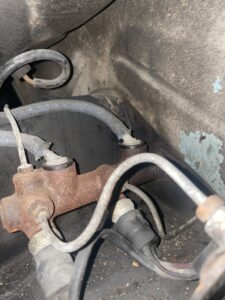It’s sometimes exciting to get involved in making a repair, but this wasn’t one of those times.
I had noticed a slow leak in the brake system for a couple of years. I even had a few mechanics look at it, but they couldn’t find any leak. So last summer I took off the front wheel and took a good look at my master cylinder and while it wasn’t visibly wet, you could see that leaking had been going on there for a long time.

So, my first piece of advice if you are going to do this is to probably pull the gas tank. I didn’t pull it and more than once wished I had. If you are going to make the replacement like I did, get ready for some really interesting body positions, and possibly some cursing as well.
First let’s just briefly talk about where it’s located. It’s directly behind the drivers front wheel. So loosen those lug nuts, jack up your front end, and then pull that wheel. Set it off to the side, maybe for weeks or months. I had a lot going on over the summer so my buddy Scott referred to my ’66 Beetle as “Garage Art”.
The first step is to drain your existing brake fluid from your reservoir. Once that’s done, it’s time to remove the brake lines from the master cylinder. As rusty as mine were, I expected issues getting them loose. However, they came off easily. Next I removed the brake sensor wires and the line running from the reservoir to the master cylinder. Now, I could move on to removing the master cylinder.
Between your brake pedal on the inside of the car, and the master cylinder are two bolts. You will need to pull your carpeting down to get to them. When you loosen them, they come directly out of the master cylinder housing. Resist the temptation to pull these bolts out and set them in your pedal area. They need to stay in the holes where they were located. Why? Because the firewall is actually made of two sheets of metal. In between those two sheets of metal lies a dead space.
There are metal floating sleeves that each bolt passes through. If you pull the bolt out, the sleeve will fall down between the two sheets of metal. This didn’t happen to me because Scott had warned me in advance. However, I have heard from others that it happened to, that it was a nightmare to fish that cylinder back up out of the well.
Once those bolts came out of the master cylinder, I was able to pull the old master cylinder out and clean the area.

Now, it was a matter of waiting for the new Master Cylinder. After it arrived while I was attempting to fit the new brake fluid flexible lines on the plastic shafts, I noticed one was cracked. That one was returned and a new one came about two weeks later. I also ordered new brake sensors as well. I don’t think I needed them, but I figured while I was in there……
Now, here is where things get a little sketchy from my perspective. I have talked about how I am a purist when it comes to keeping my 66 stock. In this case when I purchased it, the previous owner had put in a dual chamber master cylinder (you can see that in the first picture above). Dual chamber master cylinders were stock in 1967. That introduced some extra safety to the beetle. What the previous owner failed to do was to put in a dual master cylinder brake reservoir. They simply ran a single line down to a T fitting, and then ran two lines to the master cylinder. That really defeats the purpose of a dual chamber master cylinder.
So, being a purist I had a decision to make: do I go with the safety of having a dual chamber or revert to a single brake line. If I go back to a single stage master cylinder and lose all my brake fluid, I have no brakes. In a dual chamber, you can have a leak in one of the two systems and still have brakes. I opted to stay with the two chamber master cylinder. However, I also needed to add a dual chamber reservoir. This required drilling.
So I contacted my buddy scott and he agreed with my decision and brought a step drill so we could make two additional holes behind the reservoir for the additional flexible brake line hoses. Anyone that knows me, knows that I don’t like drilling into good metal. However, there really was no other option that made sense.

It became almost impossible to hook up the hydraulic hoses after this. There is just no room to work under there to feed things through. After much cursing and probably four hours, I got everything connected. I would never attempt this again without removing the gas tank. It just isn’t worth the frustration.
Additionally, bleeding the brakes was a nightmare…but that might be another story.


In short, this job is not a difficult one from a mechanical standpoint. What makes it a nightmare is where it is located.
